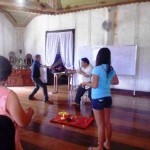- escrimadores, dauis, bohol july 2012
- taken at the filipino american exhibit at the national steinbeck center, salinas califas 2012
as i’ve mentioned at a prior post (bridging bridges of big minds posted 7 15 2012) i was not really sure how the eskrima dance of emotional truth was going to flow. participants of a writer’s workshop conducted by Tony Perez from the US Embassy in Manila were instructed to dance as part of a closing activity. pohon, it went well. good spirits are with us. last year, for the first time in my life, i joined an all-women’s musical group called DIWA, primarily filipina-americans but also mixed with balik-bayans and mga katutubo, kalinga women (see photo above taken by M.A. Fink 2012 during an opening exhibit). with the exception of myself who had little to none musical or dance background although i am a music and dance lover and advocate, the members combined had a diversity of musical backgrounds ranging from kulintang players, knowledge of traditional northern and southern Philippine dances, modern dance, african dance, and many more. DIWA are mothers, aunties, wives, girlfriends, grandmothers, friends to many. for rehearsals/practice, we meet 1-2x a month at member’s residences in the san francisco bay area region. last year in a DIWA rehearsal, we learned a Kalinga song of approval from Jenny Bawer. to my delight surprise, one of the participants, Paul, brought camagong fighting sticks. on a whim, i invited him to play escrima with a clear verbal disclaimer that i had only taken a handful of escrima classes a few weeks prior. He consented, how was i to know that he was a good escrimadores! courageously, i decided to share and sing this song as the ending for the escrima dance of emotional truth, what else could follow the escrimadores’s movements and clacking of the sticks as the sole sound of music simultaneously along a round-robin procession of boholano writers holding selected filipino-american voices taken from a filipino-american historical timeline, each note hand-written on a green sticky notepad on top of book give-aways for the boholano writers. an unsure process that started with a blessing and an offering resulted with the boholono writers’s in a circle with arms linked together, swaying and singing ‘sur we ee tutuwa ka ma amin, sur we ee, oh me oh me oh me om, pe pe om.’ mabuhay!

